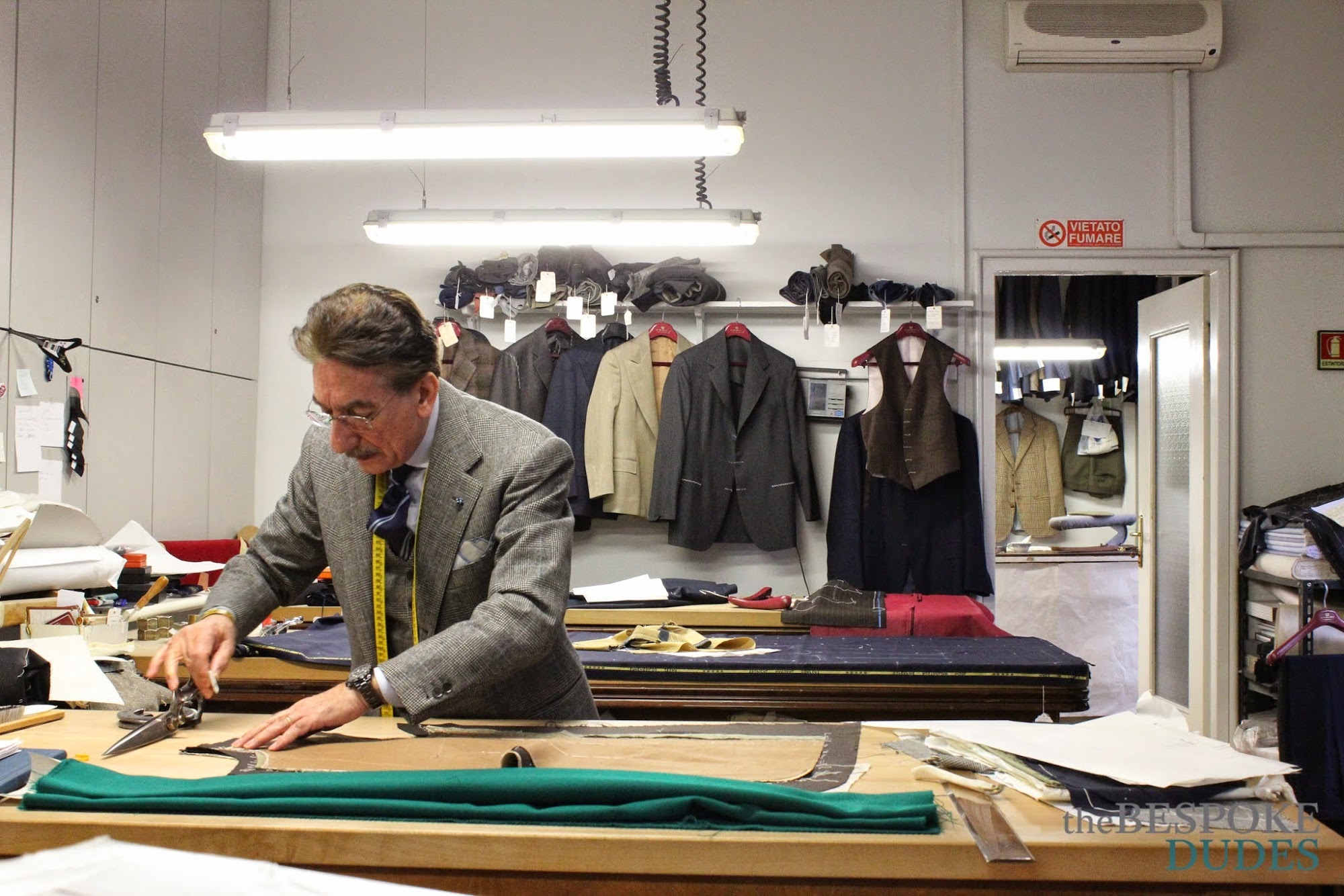The Article - L'articolo
The whole first floor of a building in Via Farebenefratelli, Milan. Almost thirty employees, 70% is the percentage of foreign customers. It’s A. Caraceni, the mecca of the Milanese tailoring school, founded by Augusto Caraceni in 1946, upon the success obtained in Paris and Rome. I meet the Master Carlo Andreacchio and his son Massimiliano. Carlo is the son-in-law of Mario Caraceni, son of Augusto. Mario had two daughters, one of which is Rita Maria, mother of Massimiliano and wife of Carlo. It’s a story of a descent of tailors, all hailing from Ortona a mare, Abruzzo. Two years ago, when the blog was newly born, I had interviewed Nicoletta Caraceni (read it here), daughter of Ferdinando, but both claim no blood-relation. Every family declares to be the true one, every tailor claims to have worked there and some even have been charged with abuse of the name Caraceni, for a personal profit. “If all the rumors were true, we should now own the entire building”, says Carlo whilst smiling through his mustache.
In this sartorial gotha, where the most important businessmen come from all over the world, twentysix measurements are taken for ever new customer. The fronts of the model are made of cloth “because the cloth keeps the shape given by the tailor”, while backs and sleeves are made of paper. “Once we used heavier English fabrics, now they’re lighter” I am told by Massimiliano. Half of the fabrics used here are Italian, Vitale Barberis Canonico and Loro Piana; he rest comes from England.
80% of a suit by A. Caraceni is hand-made. Also sides and center–back are hand-made, the latter is folded and not cut when the blazer is unlined. Their signature is for sure a fitting armhole, yet comfortable, little shoulder padding, a bit of rullino and low collar. The inside is made of camelhair and horsehair, canvas and cotton, so the jacket is heavier than a Neapolitan one. Watch out: never ever ask here for a front dart till the bottom like in Napoli, it would be considered as a rough flaw!
Curiosity: at Caraceni they keep a secret regarding the cut; it’s handed down from one generation to another and the young Massimiliano himself got to know it only recently, after years of apprenticeship. For security reasons, it has been copied out in a book, accurately kept by the family. Finally, I was amused to discover their rule of the buttons: if even on the front of the jacket, even on the sleeve too. "When in Rome..."
Bespoke hugs,Fabio_______________
L’intero primo piano di un palazzo in Via Fatebenefratelli a Milano. Circa trenta addetti, percentuale di clientela straniera che ammonta al 70%. Si tratta di A. Caraceni, la mecca della scuola sartoriale milanese fondata da Augusto Caraceni nel 1946, dopo il successo di Parigi e Roma. E’ la storia di una stirpe di sarti, condita da trionfi e divisioni interne, nonostante l’origine comune rinvenibile in quella piccola Ortona a mare, in provincia di Chieti, Abruzzo. Incontro il Maestro Carlo Andreacchio e suo figlio Massimiliano. Carlo è genero di Mario Caraceni, a sua volta figlio di Augusto, il fondatore. Mario ha avuto due figlie, una delle quali è Rita Maria, madre di Massimiliano e moglie di Carlo. Circa due anni fa, all’inizio di quest’avventura, avevo intervistato Nicoletta Caraceni (articolo qui), figlia di Ferdinando, ma entrambi i Caraceni dichiarano di non essere parenti. Ho capito che ogni famiglia qui rivendica l’unicità, innumerevoli sarti o presunti tali millantano di essersi addestrati alla loro corte, e c’è anche chi è stato accusato di abuso del nome Caraceni per indebito ritorno d’immagine. “Se tutti quelli che dichiarano di aver lavorato da noi dicessero la verità, adesso avremmo tutto il palazzo” – sorride tra i baffi il Signor Carlo.
Nel gotha sartoriale che ha vestito e continua a vestire capitani d’azienda, imprenditori e artisti, si prendono ben ventisei misure ad ogni nuovo cliente. I davanti del modello sono in panno “perché il tessuto mantiene la tipica bombatura sartoriale del petto”, mentre in carta si fanno i dietro e le maniche. “Un tempo utilizzavamo tessuti pesanti e inglesi, ora sono più leggeri”, mi spiega Massimiliano. Per metà, infatti, sono tessuti nostrani, di Vitale Barberis Canonico e Loro Piana; i restanti sono inglesi.
Un abito Caraceni è fatto per l’80% a mano. A mano vengono fatti anche i fianchi e il centro-dietro, che nella giacca sfoderata è rimboccato e non tagliato. La loro firma è un giromanica aderente, ma che permette i movimenti. La giacca Caraceni ha un po’ di spallina, poco rullino e collo non alto. L’aggiunta di crine di cavallo e pelo cammello a canvas a silesia, la rendono sicuramente pù pesante di una giacca napoletana. Attenzione: mai chiedere qui la ripresa fino al fondo come a Napoli, sarebbe giudicata alla stregua di un grossolano errore, se non un’offesa!
Curiosità: c’è un segreto relativo a una fase del taglio, che viene tramandato di padre in figlio da generazioni, svelato allo stesso Massimiliano dopo anni di apprendistato. Per sicurezza è stato trascritto in un libro, custodito con comprensibile gelosia dalla famiglia. Interessante, infine, la loro regola dei bottoni: se pari sul davanti, pari anche sulla manica. "Paese che vai…"
Frac dating back to the 40's - Un frac degli anni '40
Low collar - Collo basso
Hall of fame
Left: Model made of cloth; Right: paper model - Sinistra: Modello in tessuto; Destra: modello in carta
Paper models - Cartamodelli
Massimiliano Andreacchio
Maestro Carlo Andreacchio
Shoulder padding - Ovatta per spalline
Caraceni's armhole - Giromanica di Caraceni
If you like what we are doing here, please consider following TBD on Facebook - Tumblr - Instagram - Twitter
Bespoke Hugs,
Fabio
A. Caraceni - The cradle of Milanese tailoring
8 Maggio 2014







